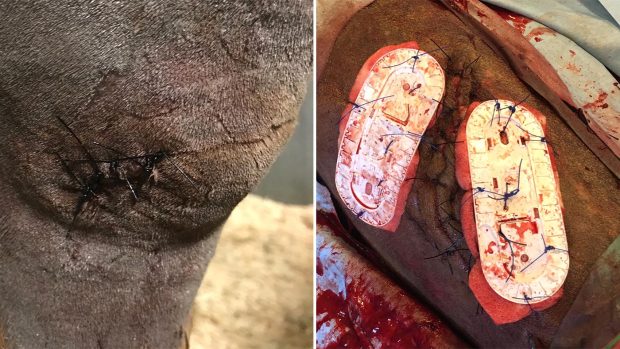All wounds result in scarring because although nature makes a very good attempt to restore normal tissue function as fast as possible, it cannot recreate exactly the normal anatomy at the site of an injury.
The cosmetic appearance of scars is often of concern to horse owners because this can affect the value and appearance of the horse.
Currently, it is probably impossible to avoid scarring at the site of a significant wound that damages the whole depth of the skin. It is therefore important to limit the extent of scarring through very careful wound management.
The faster a wound closes, the smaller the scar will be — wounds created surgically with a scalpel or accidental wounds that cause minimal damage to the adjacent structures heal rapidly — especially when the size of the wound is reduced by sutures.
Stitching a clean wound closed will create the minimum amount of scarring. Any delays in healing or complications arising within the wound that affect the healing process will leave a larger scar.
There are measures that can be taken to limit the severity of a scar at a healed wound site. Once the wound has healed, restoring or maintaining tissue hydration seems to be a significant benefit in ensuring that the scarring is minimised.
It is sometimes possible to limit scarring by the use of corticosteroids — these drugs reduce the inflammatory responses and so limit the scar tissue formation. Probably the commonest site for this approach is in certain eye injuries. This treatment can be applied only to a healed injury, and the exact timing of the applications is critical.
Recently there has been a major scientific focus on stem cell technology. There are several new methods that exploit this technique and the results are remarkably good. However, there is still much research needed to deliver a clinically useful response.
A second recent scientific discovery is the value of protein mediators, called growth factors, within the wound site. Manipulation of these chemicals can result in far less scarring. This technology, which is still very expensive and difficult to carry out, has been applied to some human wounds with remarkable success. It is likely that the method could eventually be applied to horses.
Can scars be removed?
There is a strong temptation to consider removing scars for cosmetic reasons, but there are significant dangers from this approach. The surgical excision will usually be far more difficult than it looks from outside and the resulting scar from the surgery may be worse than the original one.
In some cases, such as broken knees following a fall on to concrete or road surfaces, the scar can be removed surgically and the site grafted with a piece of skin taken from another site where its removal will not be noticed. While this is an attractive option, there are major risks. The graft may not “take” and the hair in the graft may not grow back in the same format, so there could be even more problems.
It is very doubtful whether the horse minds having a scar at all, so the procedures tend to be more for the owner than the horse.
|
||
 |
||


 Get up to 19 issues FREE
Get up to 19 issues FREE TO SUBSCRIBE
TO SUBSCRIBE 



